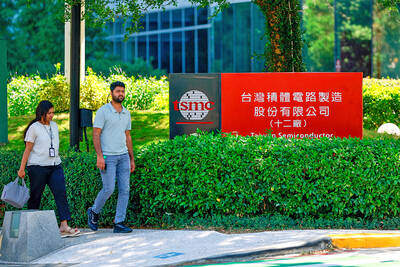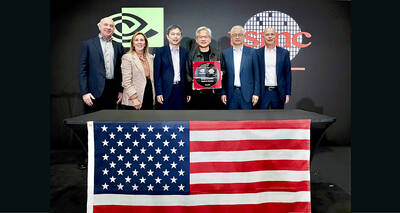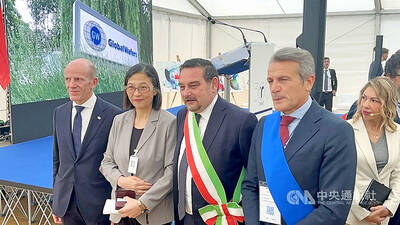The Taliban-led administration in Afghanistan on Thursday signed its first international contract to extract oil from the northern Amu Darya basin as the group seeks to increase revenue.
The agreement with a subsidiary of China National Petroleum Corp (中國石油天然氣集團), was inked in Kabul in the presence of Chinese Ambassador to Afghanistan Wang Yu (王愚) and the Taliban’s Deputy Prime Minister for Economic Affairs Mullah Abdul Ghani Baradar.
The pact would “strengthen Afghanistan’s economy and increase its level of oil independence,” Baradar said at the signing.
Wang, whose country does not recognize the Taliban government, said that the 25-year contract would support Afghanistan’s push for self-sufficiency.
Xinjiang Central Asia Petroleum and Gas Co (疆中亞石油天然氣) would invest as much as US$150 million in the first year and US$540 million over the subsequent three years to explore five oil and gas blocks, said Shahabuddin Delawar, the Taliban’s acting minister of mines and petroleum.
The blocks are in a 4,500km2 area in northern Afghanistan.
The militant group would earn 15 percent royalty fees from the 25-year contract.
Daily oil production would start at about 200 tonnes and gradually rise to about 1,000 tonnes. The five blocks are estimated to hold 87 million barrels of crude oil, a previous survey showed.
Xinjiang Central Asia Petroleum and Gas would also build Afghanistan’s first crude oil refinery, Delawar said.
If it failed to meet all the contract obligations within a year, the contract would be terminated, he said.
China National Petroleum was awarded the same projects in 2011 by the previous government, but the deal was scrapped years later by then-Afghan president Ashraf Ghani due to delays and lack of progress in work.
The Taliban has regarded the restart of this project as significant as so far investments have been from private or individual entrepreneurs, said Raffaello Pantucci, a senior associate fellow at the Royal United Services Institute in the UK.
“This contract is clearly quite significant for the cash-strapped Taliban, because they’ve been desperate for this kind of investment,” Pantucci said. “Strategically, this isn’t going to be a game changing oil commitment for China, as it’s a relatively limited opportunity.”
The Taliban has harbored hopes that China would boost investments in the country’s rich resources, estimated to be worth US$1 trillion.
The group sees the investments as a way to fix an economy that has nearly collapsed after international aid, accounting for 40 percent of the nation’s GDP, was halted following the chaotic withdrawal of US troops in 2021.
However, attacks by the Islamic State group in Afghanistan, such as the one that targeted Chinese businesspeople and executives in a hotel last month, have made China wary about investing.
Then there is also the presence of the East Turkistan Islamic Movement, a Xinjiang-based separatist group, that has kept Beijing cautious.
Before China National Petroleum came into the picture, Metallurgical Corp of China Ltd (中國冶金科工) won almost a US$3 billion bid in 2008 to mine one of Afghanistan’s largest copper deposits in Logar Province, but it never made headway due to a series of delays mostly to do with security concerns.
The Taliban says that it is renegotiating the contract.
The Taliban has repeatedly asked international companies to invest in Afghanistan’s natural resources, even though it has drawn widespread international condemnation for its rules barring women from education and jobs.
China has consistently said it would never interfere in the country’s affairs.
Although no nation has officially recognized the Taliban government, China, Russia and Pakistan have maintained close political and economic ties.
Afghanistan consumes about 1.3 million tonnes of fuel annually, imported mostly from Uzbekistan, Turkmenistan and Iran.

RECYCLE: Taiwan would aid manufacturers in refining rare earths from discarded appliances, which would fit the nation’s circular economy goals, minister Kung said Taiwan would work with the US and Japan on a proposed cooperation initiative in response to Beijing’s newly announced rare earth export curbs, Minister of Economic Affairs Kung Ming-hsin (龔明鑫) said yesterday. China last week announced new restrictions requiring companies to obtain export licenses if their products contain more than 0.1 percent of Chinese-origin rare earths by value. US Secretary of the Treasury Scott Bessent on Wednesday responded by saying that Beijing was “unreliable” in its rare earths exports, adding that the US would “neither be commanded, nor controlled” by China, several media outlets reported. Japanese Minister of Finance Katsunobu Kato yesterday also

‘DRAMATIC AND POSITIVE’: AI growth would be better than it previously forecast and would stay robust even if the Chinese market became inaccessible for customers, it said Taiwan Semiconductor Manufacturing Co (TSMC, 台積電) yesterday raised its full-year revenue growth outlook after posting record profit for last quarter, despite growing market concern about an artificial intelligence (AI) bubble. The company said it expects revenue to expand about 35 percent year-on-year, driven mainly by faster-than-expected demand for leading-edge chips for AI applications. The world’s biggest contract chipmaker in July projected that revenue this year would expand about 30 percent in US dollar terms. The company also slightly hiked its capital expenditure for this year to US$40 billion to US$42 billion, compared with US$38 billion to US$42 billion it set previously. “AI demand actually

Jensen Huang (黃仁勳), founder and CEO of US-based artificial intelligence chip designer Nvidia Corp and Taiwan Semiconductor Manufacturing Co (TSMC, 台積電) on Friday celebrated the first Nvidia Blackwell wafer produced on US soil. Huang visited TSMC’s advanced wafer fab in the US state of Arizona and joined the Taiwanese chipmaker’s executives to witness the efforts to “build the infrastructure that powers the world’s AI factories, right here in America,” Nvidia said in a statement. At the event, Huang joined Y.L. Wang (王英郎), vice president of operations at TSMC, in signing their names on the Blackwell wafer to

Taiwan-based GlobalWafers Co., the world’s third largest silicon wafer supplier, on Wednesday opened a 12-inch silicon wafer plant in Novara, northern Italy - the country’s most advanced silicon wafer facility to date. The new plant, coded “Fab300,” was launched by GlobalWafers’ Italian subsidiary MEMC Electronics Materials S.p.A at a ceremony attended by Taiwan’s representative to Italy Vincent Tsai (蔡允中), MEMC President Marco Sciamanna and Novara Mayor Alessandro Canelli. GlobalWafers Chairwoman Doris Hsu (徐秀蘭) said the investment marked a milestone in the company’s expansion in Europe, adding that the Novara plant will be powered entirely by renewable energy - a reflection of its